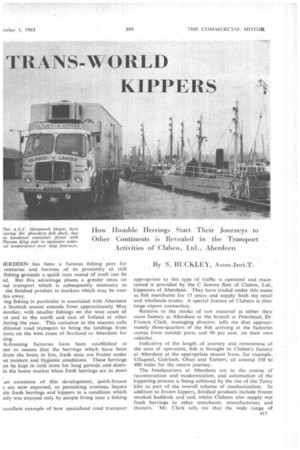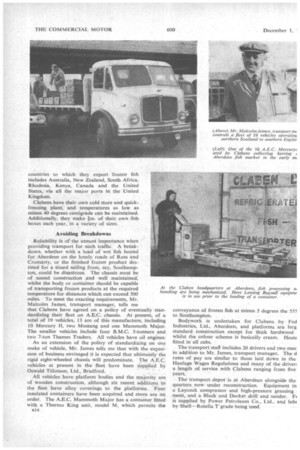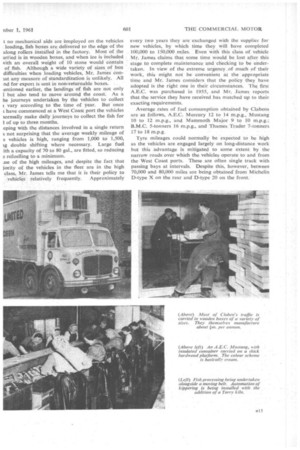TRANS-WORLD KIPPERS
Page 47

Page 48

Page 49

If you've noticed an error in this article please click here to report it so we can fix it.
How Humble Herrings Start Their Journeys to Other Continents is Revealed in the Transport Activities of Claben, Ltd., Aberdeen By S. BUCKLEY, Assoc.Inst.T.
lERDEEN has been a famous fishing port for centuries and because of its proximity to rich fishing grounds a quick turn round of craft can be ed. But this advantage places a greater onus on lad transport which is subsequently necessary to • the finished product to markets which may be over lies away.
ring fishing in particular is associated with Aberdeen e Scottish season extends from approximately May iternber, with smaller fishings on the west coast of -id and to the north and east of Ireland at other during the year. This variation in the seasons calls ditional road transport to bring the landings from ports on the west coast of Scotland to Aberdeen for sing.
:k-freezing factories have been established at een to ensure that the herrings which have been from the boats in live, fresh state are frozen under )st modern and hygienic conditions. These herrings en be kept in cold store for long periods and distriin the home market when fresh herrings are in short
an extension of this development, quick-frozen s are now exported, so permitting overseas buyers in fresh herrings and kippers in a condition which asly was enjoyed only by people living near a fishing excellent example of how specialized road transport appropriate to this type of traffic is operated and maintained is provided by the C licence fleet of Claben, Ltd., kipperers of Aberdeen. They have traded under this name as fish merchants for 15 years and supply both the 'retail and wholesale trades. A special feature of Clabens is their large export connection.
Relative to the intake of raw material at either their main factory at Aberdeen or the branch at Peterhead, Dr. Francis Clark, managing director, tells me that approximately three-quarters of the fish arriving at the factories comes from outside ports and 90 per cent, on their own vehicles.
Indicative of the length of journey and remoteness of the area of operation, fish is brought to Claben's factory at Aberdeen at the appropriate season from, for example, Lillapool, Gairloch, Oban and Tarbert, all around 350 to 400 miles for the return journey.
The headquarters at Aberdeen are in the course of reconstruction and modernization, and automation of the kippering process is being achieved by the use of the Torry kiln as part of the overall scheme of mechanization. In addition to frozen kippers, finished products include frozen smoked haddock and cod, whilst Clabens also supply wet fresh herrings to other merchants, manufacturers and Canners. Mr. Clark tells nne that the wide range of countries to which they export frozen fish includes Australia, New Zealand, South Africa, Rhodesia, Kenya, Canada and the United States, via all the major ports in the United Kingdom.
Clabens have their own cold store and quickfreezing plant, and temperatures as low as minus 40 degrees centigrade can be maintained. Additionally, they make fin. of their own fish boxes each year, in a variety of sizes.
Avoiding Breakdowns Reliability is of the utmost importance when providing transport for such traffic. A breakdown, whether with a load of wet fish bound for Aberdeen on the lonely roads of Ross and Cromarty, or the finished frozen product destined for a timed sailing from, say, Southampton, could be disastrous. The chassis must be of sound construction and well maintained, whilst the body or container should be capable of transporting frozen products at the required temperature for distances which can exceed 500 miles. To meet the exacting requirements, Mr. Malcolm James, transport manager, tells me that Clabens have agreed on a policy of eventually standardizing their fleet on A.E.C. chassis. At present, of a total of 19 vehicles, 13 are of this manufacture, including 10 Mercury H, two Mustang and one Mammoth Major. The smaller vehicles include four B.M.C. 5-tonners and two 7-ton Thames Traders. All vehicles have oil engines.
As an extension of the policy of standardizing on one make of vehicle, Mr. James tells me that with the expansion of business envisaged it is expected that ultimately the rigid eight-wheeled chassis will predominate. The A.E.C. vehicles at present in the fleet have been supplied by Oswald Tillotson, Ltd., Bradford. . . .
All vehicles have platform bodies and the majority are. of wooden construction, although six recent additions to the fleet have alloy coverings to the platforms. Four insulated containers have been acquired and more are on order. The A.E.C. Mammoth Major has a container fitted with a Thermo King unit, model M, which permits •the conveyance of frozen fish at minus 5 degrees the 555 to Southampton.
Bodywork is undertaken for Clabens by Fed Industries, Ltd., Aberdeen, and platforms_ are larg standard construction except for thick hardwood whilst the colour scheme is basically cream. Heate fitted in all cabs.
The transport staff inclUdes 20 drivers and two mec in addition to Mr. James, transport manager; The d rates of pay are similar to those laid down in the Haulage Wages Regulations and many of the driven a length of service with Clabens ranging from five years.
The' transport depot-is at Aberdeen alongside the quarters now .under reconstruction. Equipment in a Laycock 'compressor and high-pressure greasing merit, and a Black and Decker drill and-sander. Ft is supplied by Power Petroleum Co., Ltd., and lubt by Shell—Rotella T grade being 'used. t no mechanical aids are employed on the vehicles loading, fish boxes are delivered to the edge of the along rollers installed in the factory. Most of the arried is in wooden boxes, and when ice is included vith an overall weight of 10 stone would contain of fish. Although a wide variety of sizes of box difficulties when loading vehicles, Mr. James conla any measure of standardization is unlikely. All nd for export is sent in non-returnable boxes.
Lentioned earlier, the landings of fish arc not only 1 but also tend to move around the coast. As a he journeys undertaken by the vehicles to collect vary according to the time of year. But once ; have commenced at a West Coast port the vehicles iormally make daily journeys to collect the fish for 1 of up to three months.
eping with the distances involved in a single return s not surprising that the average weekly mileage of s vehicles is high, ranging from 1,000 to 1,500, ig double shifting where necessary. Large fuel ith a capacity of 70 to 80 gal., are fitted, so reducing a refuelling to a minimum.
Ise of the high mileages, and despite the fact that jority of the vehicles in the fleet are in the high class, Mr. James tells me that it is their policy to vehicles relatively frequently. Approximately every two years they are -exchanged with the supplier for new vehicles, by which time they will have completed 100,000 to 150,000 miles. Even with this Class of vehicle Mr. James claims that some time would be lost after this stage to complete maintenance and checking to be undertaken. In view of the extreme urgency . of much of their work, this might not be convenient at the appropriate time and Mr. James considers that the policy they have adopted is the right one in their circumstances. The first A.E.C. was purchased in 1955, and Mr. James reports that the service they have received has matched up to their exacting requirements.
Average rates of fuel consumption obtained by Clabens are as follows, A.E.C. Mercury 12 to 14 m.p.g., Mustang 10 to 12 m.p.g., and Mammoth Major 9 to 10 m.p.g.; B.M.C. 5-tonners 16 m.p.g., and Thames Trader 7-tanners 17 to 18 m.p.g.
Tyre mileages could normally be expected to be high as the vehicles are engaged largely on long-distance work but this advantage is mitigated to some extent by the narrow roads over which the vehicles operate to and from the West Coast ports. These are often single track with passing bays at intervals. Despite this, however, between 70,000 and 80,000 miles are being obtained from Michelin D-type X on the rear and 0-type 20 on the front.
































































































































